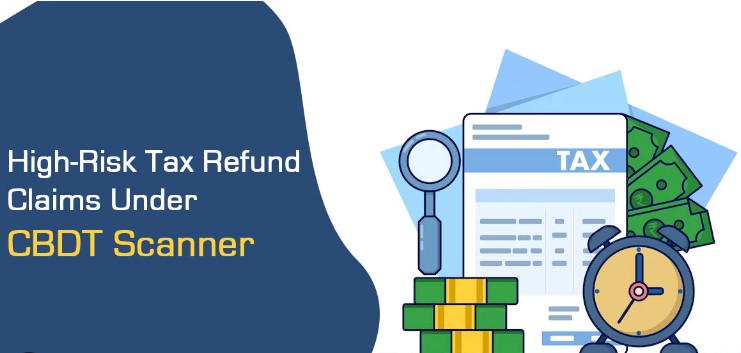
High refund cases under CBDT Scanner – Instructions for the AY 2024-25
Published In : EvoBreyta Download
Author : Navneet Singal
High refund cases under CBDT Scanner – Instructions for the AY 2024-25
It has been noticed that many return filers are claiming excess refunds through various means such as wrong claim of TDS credit, under reporting of income, over stating of deductions, claim of bogus expenses etc. Accordingly, some cases have been identified based upon approved risk rules for high-risk refunds.
For a detailed examination of such cases, the CBDT has issued instruction to its field officers for verification of High-Risk refund (HRR) cases, which can be summarized as follows:
1) SOP for CIT(TDS) - TAN level clusters (Instruction No. 80)
2) SOP for Jurisdictional Assessing Officer (JAO) (Instruction No. 81)
3) SOP for Directorate of Investigation - email-based clusters (Instruction No. 82)
(The instructions are enclosed herewith for your ready reference along with this Blog)
1) SOP for CIT(TDS) - TAN level clusters (Instruction No. 80)
These cases consist of ITR filers, in which common employer Tax Deduction and Collection Account Number (TAN) have been reported. Details of such high-risk clusters are being sent to the respective jurisdictional CIT(TDS) for the purpose of verification of suspicion that whether false claims of refunds have been made in an organized manner or through a single key person
While verifying the AO will take care of following aspects:
(i) To examine if the TAN of the TAN cluster has been flagged in High-Risk Refund rules in 3 or more years out of last 8 / available years as available in Insight Portal. If yes, the feedback “Further risk assessment required” must be given.
(ii) To examine if any penalty order has been passed or prosecution has been launched on the deductor for any TDS default in any of the latest 3 Penalty Orders /prosecution proceedings out of last 8 years as available in TRACES AO Portal. If yes, the feedback “Further risk assessment required” must be given.
(iii) To examine if any demand u/s 201 was raised for 3 or more years out of last 8 years in TRACES AO Portal. If yes, the feedback “Further risk assessment required” must be given.
2) SOP for Jurisdictional Assessing Officer (JAO) (Instruction No. 81)
Some cases have been identified based upon certain rules. The details of these cases have been made available to JAO through Insight Portal. JAO shall provide the feedback "Further risk assessment required" only if any of the following-mentioned criteria is fulfilled. If not, JAO shall provide feedback "ITR can be processed". The criteria are as follows:
(i) To examine if any major claim of deductions etc. has been disallowed in any of the latest 3 assessment orders (orders including assessment orders passed u/s 143(3)/144/147/153A/153C/263 of the Income Tax Act-1961) out of last 8 years assessment order data as available in ITBA Portal. After examining the disallowance, JAO shall check the status of appellate proceedings. Only in cases where no appeal has been filed or the disallowance stands confirmed as on date, the feedback “Further risk assessment required” is required to be given.
(ii) To examine if any penalty order has been passed for any incorrect submission of facts in any of the latest 3 Penalty Orders out of last 8 years as available in ITB Portal. If yes, the feedback “Further risk assessment required” must be given.
(iii) To examine if taxpayer has revised return and increased claim of refunds in 3 or more years out of the last 8 years as available in AO Portal of e-filing. If yes, the feedback “Further risk assessment required” must be given.
(iv) To examine if a PAN has been flagged in High-Risk Refund rules in 3 or more years out of last 8 / available years as available in Insight. If yes, the feedback “Further risk assessment required” must be given.
(v) To examine if any information with respect to CRIU/VRU uploads of the latest 3 years is available (and where order taking into account the said uploads has not been passed) for taxpayer in profile views of Insight Portal, which states that the taxpayer has under reported receipt or / claimed deduction not allowable as per the Income-Tax Act, or any other information which suggests any form of tax evasion/ non-compliance on part of the assesses. If yes, then the feedback “Further risk assessment required” must be given.
3) SOP for Directorate of Investigation - email-based clusters (Instruction No. 82)
Suspicious clusters, comprising of ITRs in which common email ID has been reported, has been identified based on certain rules. Details of such high-risk clusters are being disseminated to the respective CRU [Central Registry Unit] Nodal officer for the purpose of verification of suspicion that false claims of refunds have been made in an organised manner or through a single key person.
BASIS FOR DETERMINATION OF SAMPLE:
The Sample while Investigating the HRR cases would be top 10% of the Refund claimants in the cluster or Top 10 Refund claimants of the cluster, whichever is higher. For clusters containing less than 10 ITRs, all the ITRs present in the cluster are to be treated as Sample. The FIRST SAMPLE will contain the first top 10% of the Refund Claimants in the Cluster or Top 10 Refund claimants of the cluster, the SECOND SAMPLE will contain the next 10% of the refund claimants in the cluster or next top 10 refund claimants of the cluster. Many examples and illustrations have been given in the detailed instructions.




